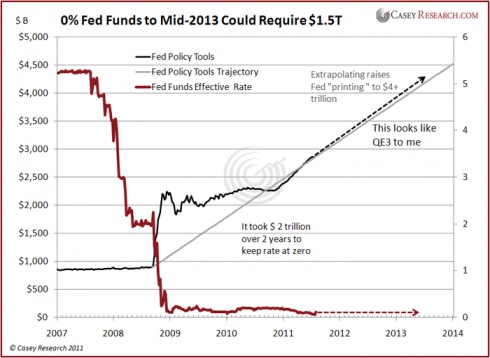Investment/Finances
Today is just “Another Futile We are Saved” type of day. Nothing has changed, no problems have been solved, in Europe, In Japan, or in the US.
” One thing is clear. The era of easy oil is over. What we all do next will determine how well we meet the energy needs of the entire world in this century and beyond” David J. O’Reilly, Chairman & CEO, Chevron Corporation, July 2005.
It would probably be a surprise to most people that U.S. oil consumption today is at the same level it was in 1997 and is 10% lower than the peak reached in 2005. The fantasies painted by “green” energy dreamers only serve to divert the attention of the non critical thinking masses from the fact our sprawling suburban hyper technological society would come to a grinding halt in a matter of days without the 18 to 19 million barrels per day needed to run this ridiculous reality show. Delusional Americans think the steaks, hot dogs and pomegranates in their grocery stores magically appear on the shelves, the thirty electronic gadgets that rule their lives are created out of thin air by elves and the gasoline they pump into their mammoth SUVs is their God given right. The situation was already critical in 2005 when the Hirsch Report concluded:
<p>The XAU/Gold ratio is bottoming and suggests that the next phase of the bull market in gold will see an improving participation by the mining stocks. </p><br /><a target=”_blank” onclick=”_gaq.push([‘_trackEvent’, ‘/_gaq.push([‘_trackEvent’, ‘/Gold083011, ‘click’]);’, ‘click’]);” href=”http://www.moneytalks.net/pdfs/Gold083011.pdf
?cm_ven=RSSFeed”> Click here to read more…</a>

What has the market turmoil of August been telling us? The answer, I suggest, is three big things….
….read more HERE
The Fed surprised the market by extending its policy of 0 to 0.25% Fed funds rate to mid-2013. The way the Fed manages to drive rates lower is to buy Treasuries with newly created money – driving the price up and the rates down. The big question is whether the policy will have a sizeable effect on markets. The chart below shows the historical jump in the Fed’s combined policy tools that were used to lower rates and bail out financial institutions through a variety of programs. These include the big purchase of mortgage-backed securities (MBS) called QE1 and the large purchase of Treasuries called QE2.
The point of the extrapolation in the chart is just to guess how much more money the Fed might need to create to keep the rate extremely low for another two years. By connecting a straight line from the start of the unusual policy tool expansions in late 2008 to today’s number, and then extending it to 2013, we can estimate that the policy might require about $1.5 trillion in order to keep the rate low.

(Click HERE to enlarge image)
The Fed doesn’t calculate the amount of money that might be required and probably doesn’t know for sure. They just keep buying on the open market until the rate comes to its target. If there were a loss of confidence in the dollar, the amount could become very large – and in the extreme, printing more money contributes to that loss of confidence, which in turn causes runaway inflation. We are not there yet. But this kind of open-ended promise is a dangerous precedent because we can’t be sure of the cost of the commitment.
However, we can say that the Fed policy is to let the dollar fall and to support the bankers and politicians who want to stimulate the economy.
[Many analysts at Casey Research foresaw the problems that are playing out today with US debt and the dropping value of the dollar. Join Bud, Doug Casey, other Casey Research experts, and special guests including John Mauldin and Mike Maloney in a free online event focusing on the American debt crisis – including how you can protect yourself and your wealth.]
Casey Research has been making money for subscribers for 30 years. We do it by spotting trends in a market or the economy early — way ahead of the crowd.
Our research staff includes geologists, economists, seasoned business analysts, and experts in precious metals, energy, technology, and natural resources. We come to our conclusions through decades of experience and plenty of hard work.
We believe that major market trends provide some of the best investment opportunities. But you have to get in early and know when to get out. Reporting on those trends and providing the information needed to profit from them is what we do in our flagship publication, The Casey Report. And we’ve helped many of its subscribers make fortunes in the process.










